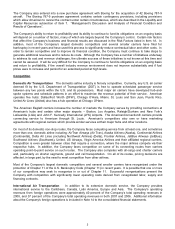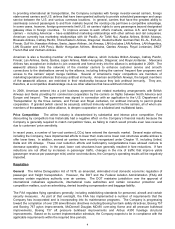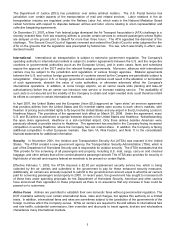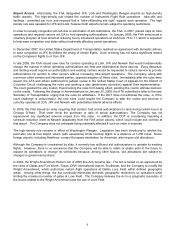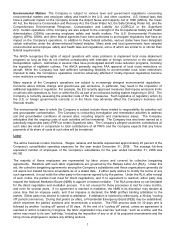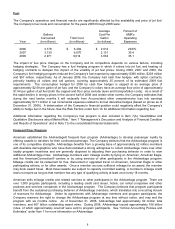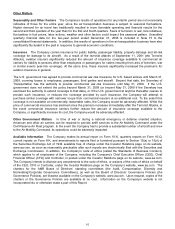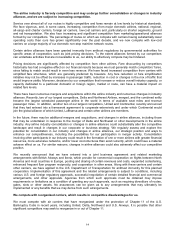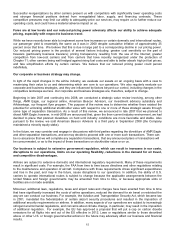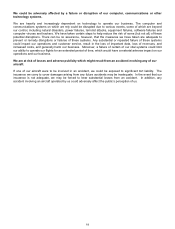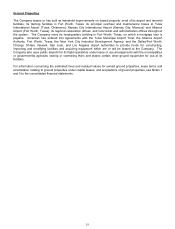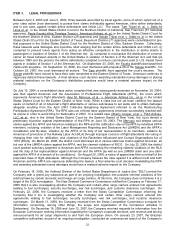American Airlines 2008 Annual Report Download - page 16
Download and view the complete annual report
Please find page 16 of the 2008 American Airlines annual report below. You can navigate through the pages in the report by either clicking on the pages listed below, or by using the keyword search tool below to find specific information within the annual report.13
Our indebtedness and other obligations are substantial and could adversely affect our business and
liquidity.
We have and will continue to have significant amounts of indebtedness, obligations to make future payments on
aircraft equipment and property leases, and obligations under aircraft purchase agreements, as well as a high
proportion of debt to equity capital. In 2009, we will be required to make approximately $1.8 billion of principal
payments on long-term debt. We expect to incur substantial additional debt (including secured debt) and lease
obligations in the future. We also have substantial pension funding obligations. Our substantial indebtedness and
other obligations have important consequences. For example, they:
•
limit our ability to obtain additional funding for working capital, capital expenditures, acquisitions and general
corporate purposes, and adversely affect the terms on which such funding can be obtained;
•
require us to dedicate a substantial portion of our cash flow from operations to payments on our
indebtedness and other obligations, thereby reducing the funds available for other purposes;
•
make us more vulnerable to economic downturns; and
•
limit our ability to withstand competitive pressures and reduce our flexibility in responding to changing
business and economic conditions.
We may be unable to comply with our financial covenants.
As of December 31, 2008 American had a secured bank credit facility (the Credit Facility) consisting of a fully
drawn $255 million revolving credit facility with a final maturity on June 17, 2009, and a fully drawn $436 million
term loan facility with a final maturity on December 17, 2010. The Credit Facility contains a liquidity covenant and a
covenant that requires AMR to maintain certain minimum ratios of cash flow to fixed charges (the EBITDAR
covenant). We were in compliance with the liquidity covenant as of December 31, 2008. In May 2008, we entered
into an amendment to the Credit Facility which waived compliance with the EBITDAR covenant for periods ending
on any date from and including June 30, 2008 and through March 31, 2009, and which reduced the minimum
ratios AMR is required to satisfy thereafter. Given fuel prices that have been very high by historical standards and
the volatility of fuel prices and revenues, uncertainty in the capital markets and about other sources of funding, and
other factors, it is difficult to assess whether we will be able to continue to comply with these covenants, and there
are no assurances that we will be able to do so. Failure to comply with these covenants would result in a default
under the Credit Facility which — if we did not take steps to obtain a waiver of, or otherwise mitigate, the default —
could result in a default under a significant amount of our other debt and lease obligations, and otherwise have a
material adverse impact on us.
Our business is affected by many changing economic and other conditions beyond our control, and our
results of operations tend to be volatile and fluctuate due to seasonality.
Our business and our results of operations are affected by many changing economic and other conditions beyond
our control, including, among others:
•
actual or potential changes in international, national, regional and local economic, business and financial
conditions, including recession, inflation, higher interest rates, wars, terrorist attacks or political instability;
•
changes in consumer preferences, perceptions, spending patterns or demographic trends;
•
changes in the competitive environment due to industry consolidation and other factors;
•
actual or potential disruptions to the air traffic control systems;
•
increases in costs of safety, security and environmental measures;
•
outbreaks of diseases that affect travel behavior; and
•
weather and natural disasters.
As a result, our results of operations tend to be volatile and subject to rapid and unexpected change. In addition,
due to generally greater demand for air travel during the summer, our revenues in the second and third quarters of
the year tend to be stronger than revenues in the first and fourth quarters of the year.


